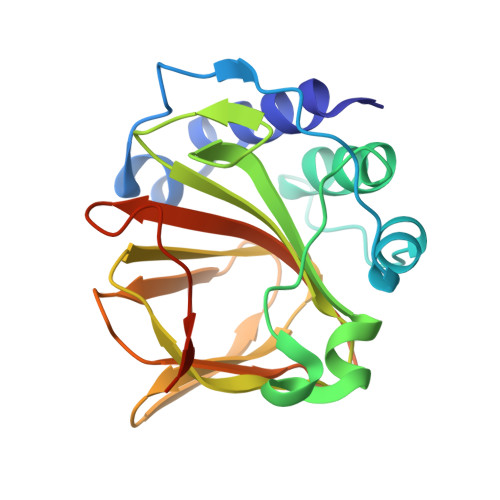New Mechanistic Insight from Substrate- and Product-Bound Structures of the Metal-Dependent Dimethylsulfoniopropionate Lyase DddQ.
Brummett, A.E., Dey, M.(2016) Biochemistry 55: 6162-6174
- PubMed: 27755868
- DOI: https://doi.org/10.1021/acs.biochem.6b00585
- Primary Citation of Related Structures:
5JSO, 5JSP, 5JSR - PubMed Abstract:
The marine microbial catabolism of dimethylsulfoniopropionate (DMSP) by the lyase pathway liberates ¡«300 million tons of dimethyl sulfide (DMS) per year, which plays a major role in the biogeochemical cycling of sulfur. Recent biochemical and structural studies of some DMSP lyases, including DddQ, reveal the importance of divalent transition metal ions in assisting DMSP cleavage. While DddQ is believed to be zinc-dependent primarily on the basis of structural studies, excess zinc inhibits the enzyme. We examine the importance of iron in regulating the DMSP ¦Â-elimination reaction catalyzed by DddQ as our as-isolated purple-colored enzyme possesses ¡«0.5 Fe/subunit. The UV-visible spectrum exhibited a feature at 550 nm, consistent with a tyrosinate-Fe(III) ligand-to-metal charge transfer transition. Incubation of as-isolated DddQ with added iron increases the intensity of the 550 nm peak, whereas addition of dithionite causes a bleaching as Fe(III) is reduced. Both the Fe(III) oxidized and Fe(II) reduced species are active, with similar k cat values and 2-fold differences in their K m values for DMSP. The slow turnover of Fe(III)-bound DddQ allowed us to capture a substrate-bound form of the enzyme. Our DMSP-Fe(III)-DddQ structure reveals conformational changes associated with substrate binding and shows that DMSP is positioned optimally to bind iron and is in the proximity of Tyr 120 that acts as a Lewis base to initiate catalysis. The structures of Tris-, DMSP-, and acrylate-bound forms of Fe(III)-DddQ reported here illustrate various states of the enzyme along the reaction pathway. These results provide new insights into DMSP lyase catalysis and have broader significance for understanding the mechanism of oceanic DMS production.
Organizational Affiliation:
Department of Chemistry, The University of Iowa , Iowa City, Iowa 52242, United States.


















